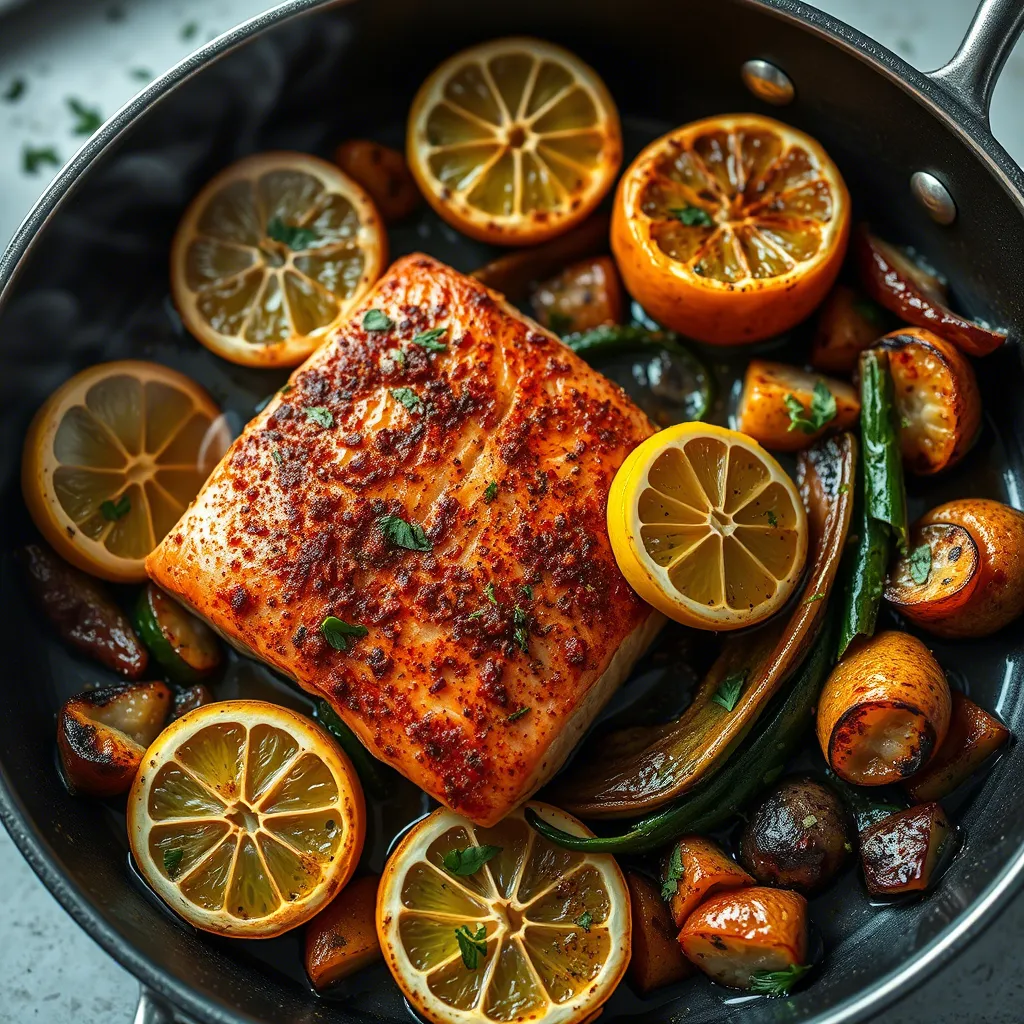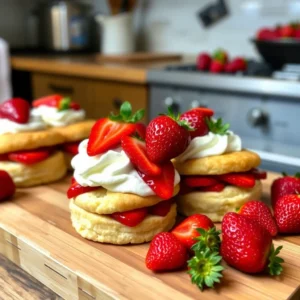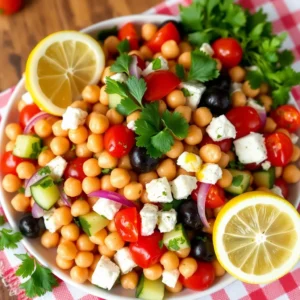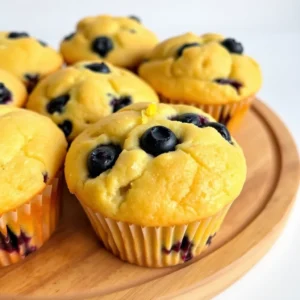Why You’ll Love This One-Pan Harissa Salmon
Let me tell you why this harissa salmon is about to become your new weeknight hero. As I write this, I can practically smell the aromatic spices and hear the sizzle of that perfect salmon fillet hitting the hot pan. If you’re anything like me — juggling work, family, and the eternal question of “what’s for dinner?” — this recipe is about to make your life so much easier.
First off, it’s a true one-pan wonder. I know that feeling when the clock strikes 5 PM and dinner feels like climbing Mount Everest. Between helping with homework, answering those last work emails, and trying to keep everyone happy, the last thing you need is a sink full of dishes. That’s where this harissa salmon swoops in to save the day — everything cooks together on a single sheet pan, which means minimal cleanup and maximum flavor.
The star of the show is harissa, a North African chili paste that packs a punch of warm spices and just the right amount of heat. Don’t worry if you’re cooking for picky eaters or spice-sensitive family members — I’ll show you exactly how to adjust the heat level so everyone at your table will be asking for seconds. It’s like having a secret weapon in your spice cabinet that transforms ordinary salmon into something extraordinary.
And can we talk about the nutritional powerhouse you’re serving? This isn’t just delicious; it’s the kind of meal that makes you feel like you’ve got this whole “balanced dinner” thing figured out. Omega-3 rich salmon paired with a rainbow of roasted vegetables means you’re ticking all those nutritional boxes without even trying. It’s the dinner equivalent of a high-five from your future self.
Time is precious, and this recipe respects that. The hands-on prep takes just 15 minutes, and while it roasts, you’re free to help with homework, take a breather, or pour yourself a well-deserved glass of wine. It’s that magical “set it and forget it” kind of cooking that feels like having a sous chef in your kitchen.
What I love most about this harissa salmon is its versatility. Having unexpected company? Double it. Need lunches for the week? This reheats beautifully. Want to impress at a dinner party without being stuck in the kitchen? This dish looks like you spent hours when really, your oven did all the work.
Before you jump into making this incredible shrimp fried rice — oops! I meant harissa salmon (though that shrimp fried rice is pretty fantastic too), let me share the story behind how this recipe became a staple in my kitchen.
The Story Behind This One-Pan Harissa Salmon
My journey with harissa salmon began on what might have been the busiest Tuesday of my life. You know those days when you’ve overcommitted yourself to approximately twelve things too many? That was me, running between meetings, picking up kids, and suddenly realizing I had promised a “proper dinner” despite having zero time to make it happen.
I had a beautiful piece of salmon in the fridge that was giving me the side-eye every time I opened the door, practically whispering, “Don’t you dare waste me on a rushed meal.” In the back of my pantry sat a jar of harissa paste I’d picked up on a whim during my “let’s try new ingredients” phase (we all have those, right?). It was a classic case of necessity being the mother of invention.
With the clock ticking and hungry mouths to feed, I threw everything on a sheet pan, crossed my fingers, and hoped for the best. When I pulled that pan out of the oven 25 minutes later, the aroma filling my kitchen was nothing short of magical. The harissa had caramelized around the edges of the salmon, the vegetables were tender with crispy bits (you know, the best parts), and somehow, this rushed experiment had turned into something spectacular.
My youngest, who typically approaches new foods with the enthusiasm of someone being asked to pet a crocodile, took one bite and declared it “actually pretty good” — which, in picky eater language, is basically a five-star review. My partner went back for seconds, then asked if there was enough for lunch the next day. That’s when I knew I had stumbled onto something special.
Since then, this harissa salmon has made appearances at family gatherings, dinner parties, and countless weeknight dinners. My sister-in-law, who claimed to “not really like fish,” asked for the recipe. My neighbor, who watches me carry groceries in with judgmental precision, stopped me to ask what smelled so good coming from my kitchen.
What started as a desperate attempt to put dinner on the table has become something of a signature dish in my home. The kids now do a little happy dance when they see the harissa jar come out of the pantry. My mother-in-law (yes, really) asked me to write down the recipe for her collection, which is basically the culinary equivalent of being knighted.
But what makes me happiest about this recipe isn’t just its flavor — though trust me, it’s incredible. It’s the way it brings everyone to the table, eager and ready to connect after a long day. There’s something about the combination of smoky harissa, tender salmon, and colorful vegetables that seems to invite conversation and connection.
So as you make this recipe in your own kitchen, know that you’re not just putting dinner on the table. You’re creating a moment for your family to pause, gather, and enjoy something truly special — even on the busiest of weeknights.
Ingredients
Let’s gather everything we need for this harissa salmon masterpiece. The beauty of this recipe lies not just in its flavor but in its straightforward ingredient list. Most of these items might already be hanging out in your kitchen, ready for their moment to shine.
For the Salmon:
- 4 salmon fillets (about 6 ounces each) – Look for fillets of even thickness for consistent cooking. Wild-caught salmon offers a richer flavor if available, but farm-raised works beautifully too. The key is freshness – your salmon should smell like the ocean, not “fishy.”
- 2-3 tablespoons harissa paste – This is our star ingredient! Harissa varies in heat level depending on the brand, so adjust according to your spice tolerance. If you’re new to harissa, start with 2 tablespoons and work your way up as you get comfortable. You can find harissa in most grocery stores these days, usually near the international foods.
- 2 tablespoons olive oil – Use a good quality one here; it makes a difference. Extra virgin olive oil brings a fruity note that complements the spices perfectly.
- 2 cloves garlic, minced – Fresh is best! Those pre-minced jars can work in a pinch, but nothing beats the aroma of freshly minced garlic.
- 1 tablespoon honey – This balances the heat from the harissa and helps create a gorgeous caramelization. Maple syrup makes a fantastic substitute if you prefer.
- 1 lemon, half juiced and half sliced – We’ll use the juice in our marinade and the slices for roasting. Meyer lemons add a lovely sweetness if you can find them.
- Salt and freshly ground black pepper – Be generous here; proper seasoning is what separates good from great.
For the Roasted Vegetables:
- 1 pound baby potatoes, halved – Little gems like Yukon golds or red potatoes work wonderfully. Their waxy texture stands up to roasting without falling apart.
- 2 bell peppers (red, orange, or yellow), chunked – I prefer the sweetness of these colors over green, but use what you have!
- 1 red onion, cut into wedges – Red onions develop a gorgeous sweetness when roasted that white or yellow onions just don’t achieve in quite the same way.
- 1 medium zucchini, chunked – Look for firm, medium-sized zucchini. The really large ones can become waterlogged when roasted.
- 2 tablespoons olive oil – Again, quality matters here.
- 2 teaspoons ground cumin – This warm, earthy spice complements the harissa beautifully.
- 1 teaspoon smoked paprika – Regular paprika works too, but the smokiness adds a wonderful depth.
- ½ teaspoon ground coriander – This bright, citrusy spice ties everything together.
- Salt and freshly ground black pepper – Season with confidence!
For Garnish:
- Fresh cilantro or parsley, chopped – If you’re in the “cilantro tastes like soap” camp, parsley makes a perfect substitute.
- Lemon wedges – For that final squeeze of brightness at the table.
- ¼ cup crumbled feta cheese (optional) – The tangy, salty punch of feta against the spicy salmon is simply divine.
This might seem like a lot of ingredients at first glance, but many are spices you likely already have. If you’re missing one or two, don’t let that stop you! The beauty of this recipe is its flexibility. No zucchini? Try eggplant or summer squash. Out of feta? A dollop of Greek yogurt works wonderfully. The heart of this dish remains intact even with a few substitutions.
Now that we have our ingredients ready to go, let’s dive into how to bring this all together into a meal that looks and tastes like you spent all day in the kitchen (when really, your oven did all the heavy lifting).
Execution
Alright, let’s get cooking! This harissa salmon comes together in straightforward steps that even novice cooks can master. I’ve broken it down into clear stages so you’ll never feel lost along the way.
Step 1: Preheat and Prep Preheat your oven to 425°F (220°C). This high temperature is key for getting those beautiful caramelized edges on both the salmon and vegetables. While the oven heats up, line a large rimmed baking sheet with parchment paper or foil for easy cleanup. If you’re using foil, give it a light spray of cooking oil to prevent sticking.
Step 2: Season the Vegetables In a large bowl, combine your prepped potatoes, bell peppers, red onion, and zucchini. Drizzle with the 2 tablespoons of olive oil and sprinkle with cumin, smoked paprika, coriander, salt, and pepper. Using your hands (yes, get in there!), toss everything until each piece is evenly coated. This hands-on approach ensures better distribution than using spoons.
Step 3: Start Roasting the Vegetables Spread your seasoned vegetables in a single layer on your prepared baking sheet. If they’re too crowded, they’ll steam rather than roast, so use two pans if needed. Place the sheet in the preheated oven and set your timer for 15 minutes. The potatoes need this head start since they take longer to cook than the salmon.
Step 4: Prepare the Harissa Salmon While the vegetables get a head start, prepare your salmon. In a small bowl, mix together the harissa paste, olive oil, minced garlic, honey, and juice from half a lemon. Season with a pinch of salt and pepper. This mixture should be the consistency of a thick paste – easily spreadable but not so thin that it runs off the salmon.
Step 5: Check on the Vegetables After 15 minutes, remove the baking sheet from the oven. Give the vegetables a quick stir to promote even browning. They should be starting to soften but won’t be completely tender yet – that’s perfect!
Step 6: Add the Salmon Create four spaces among the vegetables for your salmon fillets. Place the salmon skin-side down (if your fillets have skin) in these cleared spaces. Using a spoon or brush, generously coat each fillet with the harissa mixture, making sure to cover the entire top surface. Arrange your lemon slices on and around the salmon and vegetables.
Step 7: Complete the Roasting Return the baking sheet to the oven and roast for an additional 10-12 minutes. The exact time will depend on the thickness of your salmon and how well-done you prefer it. For medium-rare salmon, look for an internal temperature of about 125°F (52°C). For medium, aim for 130°F (54°C). If you don’t have a thermometer, the salmon should flake easily with a fork but still maintain a slight translucence in the center.
Step 8: Rest and Garnish Once done, remove the sheet pan from the oven and let everything rest for about 2-3 minutes. This brief rest allows the juices to redistribute throughout the salmon, resulting in a moister final product. Just before serving, sprinkle with freshly chopped cilantro or parsley and crumbled feta if using.
Step 9: Serve and Enjoy Transfer the salmon and vegetables to plates, making sure everyone gets a good mix of all the colorful veggies. Serve with additional lemon wedges on the side for squeezing over the top. The bright acidity of fresh lemon juice cuts through the richness of the salmon and brings all the flavors into perfect harmony.
The first time I made this for my family, my teenage son (who normally communicates in grunts and eye rolls) actually said, “This is actually really good, Mom.” I nearly fell off my chair! As chef and food writer Mark Bittman explains, “Salmon is forgiving, and with a good piece of fish, it’s hard to go wrong.” I couldn’t agree more, especially when harissa is involved!
A word on timing: If you notice your vegetables are browning too quickly while the salmon isn’t quite done, you can tent the entire pan loosely with foil for the last few minutes of cooking. Conversely, if your salmon is done but the vegetables need more time, carefully transfer the salmon to a plate and return the vegetables to the oven for a few more minutes.
Don’t be alarmed if your sheet pan looks quite full – that’s intentional! As the vegetables roast, they’ll shrink slightly, making room for everything to cook properly. Just make sure there’s a bit of space between items for air circulation, which is essential for that perfect roasted texture.
Additional Tips
Let me share some insider secrets that will elevate your harissa salmon from simply delicious to absolutely unforgettable. These are the little touches and techniques I’ve perfected over countless times making this dish.
Selecting the Perfect Salmon When shopping for salmon, look for fillets with bright, moist flesh. If you can, choose center-cut pieces of equal thickness to ensure even cooking. While wild-caught salmon has a more robust flavor, farm-raised works beautifully in this recipe too. A good fishmonger can make all the difference – don’t be shy about asking which salmon came in most recently!
Harissa Heat Level Control Harissa varies dramatically in spiciness between brands. If you’re heat-sensitive or cooking for kids, start with just 1 tablespoon mixed with a tablespoon of tomato paste for color and body without the burn. For spice enthusiasts, try adding a pinch of cayenne to your harissa mixture. My personal favorite hack? Reserve a portion of the harissa mixture before adding it to the salmon, then offer it as a tableside condiment so everyone can adjust to their preference.
Make-Ahead Magic This dish is perfect for meal prep! You can prepare the harissa mixture up to 3 days ahead and store it in an airtight container in the refrigerator. The vegetables can be chopped the night before and stored in a sealed container or zip-top bag. For a true “assemble and go” weeknight dinner, prepare everything on your sheet pan in the morning, cover with plastic wrap, and refrigerate until you’re ready to cook.
Storage and Leftovers Leftover harissa salmon makes an incredible next-day lunch. Store leftovers in an airtight container in the refrigerator for up to 2 days. I recommend reheating gently in a 300°F oven until just warmed through rather than using a microwave, which can make salmon rubbery.
Even better? Try it cold! Flake the leftover salmon over a salad of mixed greens with a simple lemon vinaigrette for a lunch that will make your colleagues seriously jealous. The roasted vegetables can also be tossed with cooked quinoa or farro for a hearty grain bowl topped with the flaked salmon.
Perfect Pairings While this one-pan meal is complete on its own, I sometimes serve it with a simple side to round out the meal. A cucumber and tomato salad with a mint-yogurt dressing creates a cooling counterpoint to the spicy salmon. For a heartier meal, a side of fluffy couscous or crusty bread to soak up those amazing pan juices is divine.
Vegetable Variations The beauty of this recipe is its flexibility. Depending on the season, try:
- Spring: Asparagus, snap peas, and radishes (add these delicate vegetables in the last 10 minutes with the salmon)
- Summer: Cherry tomatoes, corn kernels, and eggplant
- Fall: Brussels sprouts, butternut squash, and red onions (give the squash the same head start as potatoes)
- Winter: Carrots, parsnips, and cauliflower
Wine Pairing Wisdom The bold flavors of harissa call for an equally confident wine. I love a slightly chilled rosé with this dish in summer, or a medium-bodied Pinot Noir in cooler months. If you prefer white, look for something with body and acidity like a Vermentino or unoaked Chardonnay.
Special Dietary Adaptations This recipe is naturally gluten-free and dairy-free (if you skip the optional feta). For a lower-carb version, replace the potatoes with cauliflower florets or radishes. If you’re watching your sugar intake, you can omit the honey and add a touch more lemon juice for balance.
The Secret to Extra Crispy Vegetables For vegetables with extra crispy edges, preheat your sheet pan in the oven before adding the oiled and seasoned vegetables. The sizzle when they hit the hot pan jumpstarts the caramelization process. Just be careful when handling that hot pan!
Remember, cooking is as much about technique as it is about ingredients. Don’t rush the roasting process – those extra few minutes in the oven are what transform good vegetables into magnificent ones. And never underestimate the power of proper seasoning – a final sprinkle of flaky sea salt just before serving makes every flavor pop.
FAQs
Can I use frozen salmon for this recipe? Absolutely! Thaw your salmon completely in the refrigerator overnight, then pat it very dry with paper towels before adding the harissa mixture. You might need to extend the cooking time by 2-3 minutes, so keep an eye on it. Frozen salmon can sometimes release more moisture during cooking, so consider placing it on a small rack within your sheet pan if you have one.
I can’t find harissa paste. What can I substitute? If harissa is elusive in your area, you can create a similar flavor profile by mixing 2 tablespoons tomato paste with 1 teaspoon each of paprika, cumin, and coriander, plus ¼ teaspoon cayenne pepper (adjust to your heat preference). Add a minced garlic clove and 2 teaspoons olive oil to achieve a similar consistency. While not identical, this will capture the essence of harissa’s warm, complex flavor.
Can I make this recipe with chicken instead? Yes! Boneless, skinless chicken breasts work wonderfully with this same preparation. The cooking time will be different – give the vegetables their 15-minute head start, then add seasoned chicken breasts and continue cooking for about 18-22 minutes, or until the chicken reaches an internal temperature of 165°F (74°C). For even more flavor, try boneless chicken thighs!
My vegetables are cooking faster than the salmon. What should I do? If you notice your vegetables browning too quickly, simply cover them with a piece of foil, leaving the salmon exposed. This will slow the vegetables’ cooking while allowing the salmon to continue roasting unimpeded. Alternatively, you can remove everything from the oven, transfer the vegetables to a bowl and cover to keep warm, then return just the salmon to continue cooking.
How spicy is this dish? Will my kids eat it? The spice level is entirely customizable! As prepared in the recipe, it’s moderately spicy – noticeable heat but not overwhelming. For a kid-friendly version, reduce the harissa to 1 tablespoon and increase the honey to 2 tablespoons for a sweeter profile. You might also set aside some plain roasted salmon for the most spice-sensitive eaters before adding the harissa to the rest.
Can I prep this entire dish ahead of time? This is a great candidate for partial prep-ahead, but I wouldn’t recommend assembling the entire dish too far in advance. The acidic lemon juice in the harissa mixture can begin “cooking” the salmon if left too long (similar to ceviche). Instead, prep your vegetables and the harissa mixture separately up to a day ahead, then assemble and bake when you’re ready to eat.
How do I know when my salmon is perfectly cooked? Perfectly cooked salmon will be just opaque throughout but still moist. If you have an instant-read thermometer, medium-rare salmon is 120°F (49°C) in the center, while medium is 130°F (54°C). Without a thermometer, gently press the top of the fillet – it should be firm but still give slightly, and flake easily with a fork while maintaining some translucency in the very center.
For salmon that’s never dry, remember chef Thomas Keller’s advice: “It’s better to slightly undercook salmon than overcook it.” You can always add a minute or two more if needed, but you can’t undo overcooked fish!
This harissa salmon has become one of my most requested recipes, and I’m thrilled to share it with you. The combination of bold spices, perfectly cooked fish, and a rainbow of vegetables creates a meal that feels special enough for company yet simple enough for a Tuesday night. As the evenings grow busier and the days shorter, having this one-pan harissa salmon recipe in your back pocket means you’re never more than 40 minutes away from a dinner that nourishes both body and soul.
The next time you’re standing in front of your open refrigerator wondering what to make for dinner, I hope you’ll remember this recipe. Not just for its flavor (though that’s reason enough!), but for the way it transforms ordinary ingredients into something extraordinary without demanding hours of your precious time. After all, that’s what good cooking is all about – creating moments of joy and connection around the table, no matter how hectic life becomes.



